This is a guest post by Social Studies Teacher and VoiceThreader, Erin Coppola-Klein.
In the time that I’ve been using VoiceThread in the classroom, I’ve come to believe that it is the program most ideally suited for meaningful, high quality social studies instruction. The most obvious benefits center around the discussion that occurs using the comment feature. Because it is asynchronous, VoiceThread provides space for students who are reluctant verbal participants in real time class discussions to have their voices heard. The struggle to figure out how to get their voice in when participating with eager speakers is removed because they can add their voice whenever they want. Students who think they don’t have anything to say can build off the comments of those who have commented before them (or take the time to realize that they do, actually, have valuable ideas to add!) Students who are working to build confidence with public speaking can record and preview their comments as many times as they need to before posting with confidence.
Over the past two years, the teaching team with whom I work has been trying to help a student build her self confidence and share her ideas with the class without much luck. Although she was a strong writer, she remained reluctant to join discussion with her voice. Imagine my surprise when, in response to a request to leave one comment, one question, and one connection on a VoiceThread that presented direct instruction, Kate left a detailed argument for an alternative point of view. Her voice was clear! It was confident! Her argument led other students to engage with her ideas! In following up with her, she said she thought it really helped to have been able to engage with the VoiceThread and then have time to digest the information. That was how she realized that she had a different point of view than the one I presented. She also mentioned that she had recorded the comment a number of times before deciding to publish it for her classmates. This year, she has built on her success on VoiceThread to participate more often in real time discussions.
A less obvious benefit is that VoiceThread shifts student focus to thinking and speaking by freeing them from the added cognitive load of writing. As a result, I am better able to meet my students developmental needs because they are often thinking much more complexly than their writing skills allow them to express. VoiceThread gives me a way to validate the critical thinking of more of my students. This is critical to developing my students’ self confidence, especially for those who are not traditionally strong students. Along those lines, I can also use comment moderation to provide private feedback to students. The quality of the comment made public creates a positive feedback loop and encourages increased buy-in. This also allows me to ensure that all student voices are included and successful.
About the Author: Erin Coppola-Klein teaches 7th and 8th grade Social Studies at Capitol Hill Day School in the District of Columbia. She moved to teaching in classrooms in 2007 after having taught on board traditionally rigged tall ships previously. She can be reached at ecoppolaklein@chds.org.
This is a guest post by educators and VoiceThreaders, Monika Myers, and Mike Ulrich.
Like many academics, we are both introverts who are quite happy never meeting new people. But, the nature of teaching requires us to occasionally step outside our isolating offices to meet new students and help foster a community within our classes. Establishing a welcoming and inclusive classroom culture on day 1 of a semester pays significant future dividends.
Many online instructors have experience with an introduction discussion board. Best practice in online teaching involves having students introduce themselves. However, the introduction discussion board can be boring and it often fails to help students make meaningful connections. VoiceThread is an excellent tool to provide a variety of different asynchronous ice-breakers. This gives students the chance to introduce themselves in a relaxed, engaged, non-threatening way.
The basic strategy is as follows. The faculty member uses VoiceThread to display a static image. The students record a short video while drawing on that static image. After exploring several possibilities, here are some of our favorite VoiceThread icebreakers.
Have students introduce themselves while playing:
- “Let’s have Lunch.”
Show a menu of a local restaurant. Ask students to record a short VoiceThread introduction while “ordering” their favorite meal (circling items they want to eat).
- “Pick a birthday present”
Display a busy collage of a lot of random images (food, travel locations, cars, TV characters, houses, the college dorms, a tree, etc.). Students can choose the images that they might want for a birthday present. This allows for a lot of interpretation! A student might circle an image of a TV because they want to watch TV, they want to buy a TV, they want to escape TV, they want to become a TV actor, they want to do something they saw on TV, etc.
- “Life story”
Use a collage of random images similar to #2. Students can use the images to tell a short story that describes a meaningful event from their life.
- “What Book Would You Read.”
Put up a busy collage of several books. Have students introduce themselves by circling a book they might enjoy.
- “Let’s Go Shopping.”
Bring up a page showing several funny mugs. Students circle the mug they want to buy.
- “Favorite place on campus”
Display a map of campus. Students can discuss their favorite places on campus.
- “Where’s Waldo?”
Show a page from an old Where’s Waldo book. Ask the student to circle the character the best describes them.
- “Boggle”
Display a boggle board (a 4 X 4 board of random letters) and ask students to find words. They can use the pencil feature to draw the words they locate.
- “Maze”
Show a maze with multiple solutions. Students can introduce themselves while trying to find a route through the maze.
- “What Do You See in the Clouds”
Look at a picture of a sky with multiple clouds. Ask students to introduce themselves while circling or point to the shapes that they notice in the clouds.
- “Would you rather?”
Select four or five options and write them on a screen. Have students circle which thing they would rather do. For example, you could list: help someone move or drink milk that expired a week ago.
We’ve found that this strategy works best if students are introducing themselves to small groups (less than 10 people) rather than the whole class. After students post their own video, they can reply to other students as well. To see this strategy in action, feel free to look at a sample here:
Some students may be uncomfortable with recording a VoiceThread introduction. We find that recording our own introductory video where we humorously mention our introversion helps these reclusive students feel more comfortable. Our introduction videos also help students see us as real people instead of an ominous voice from behind a microphone or scripted instructor in future asynchronous lectures.
EXTRA STUFF
- Favorite animals in a big animals picture?
- Drawing of world landmark buildings?
- Foods they like?
Fun exercise …
You could do other things with country/geography:
- Where would you most like to visit?
- Where have you visited as coolest site?
Where are your ancestors from?**
**1. Food
- Which country has best food?
- Put up food groups and pick favorite
- Put up restaurants you have gone to (or would go to)
- Put up any type of food to see what they might select … types of candy bars, meat, drinks, etc.
- Books
- Put up books they would like to read and pick one
- Movies
- Which is their favorite movie or tv show or channel (fox vs. cnn)
- What movie character are they most like?
- Hobbies
- What is their hobby … put some and pick
- Cars
A would you rather game?
- Would you rather be a police officer or a fireman?
- Would you rather be homeless or called bad names?
- Would you rather be a bird or a fish?
- Would you rather take a vacation to the snowy mountains or to the beach?
Pictures of houses (victorian style, adobe style, mansion, apartment in a high rise, cabin, beach hut) which house would you most like to live in?
Picture of map of seats on an airplane - which seat would you pick?
Having a positive first day of a class has multiple benefits. For students, feeling relaxed and comfortable in an environment is conducive to learning. It’s hard to learn if you feel anxious and unwelcome! For non-traditional students especially, feeling like they can be authentic in the classroom helps with retention. In general, students who feel connected to other students and the instructor end up with better outcomes in the course. Finally, getting early wins in a class helps students gain confidence.
It is challenging to think of asynchronous ways to create this kind of welcoming environment. Most instructors use an asynchronous introduction discussion board. While this does have some benefits, students often do not feel connected to other students or their instructor through this medium alone.
About the authors:
Monika Myers is an Assistant Professor at Arkansas State University. She has taught Sociology online since 2015. She can be reached at mmyers@astate.edu
Mike Ulrich is an Assistant Professor at Utah State University where he teaches management and analytics.
2020 was challenging for everyone, but it was also a time of unprecedented collaboration, innovation, and mutual support. We were inspired by how quickly and passionately educators worldwide answered the call to keep their students safe while not compromising their physical or psychological health. Everyone worked outside their comfort zone at some point by moving fully online, observing social distancing, building hybrid courses, and handling student and faculty anxiety. We are honored to be part of that effort and are excited to share what we’ve been doing.
2020 in Review
Growth Behind the Scenes
We had a lot of goals for last year, but one we didn’t expect was the explosive increase in demand when the entire world went online in March 2020. Overnight we tripled and streamlined our infrastructure, performed extensive database maintenance, and brought on additional staff to assist with keeping everything working smoothly 24/7. It was a stressful time, but we are proud to have remained fully operational without a single outage. This was trial by fire, and it has left us more than prepared for 2021.
New Assignments

October 19 was a massive day of celebration at VoiceThread. Our new assignments feature, which has been in the works for several years, was released in full. Many courses and institutions have already adopted it, and we encourage you to check it out, too!
This update offers a huge number of new features and streamlined workflows, including:
- A streamlined interface
- More control for instructors
- Editable assignments
- A “student gallery” so students can easily see classmates’ VoiceThreads
- Better feedback for students
- Much more!
Anyone using an LTI integration in their Learning Management System can use the new assignments features. You can even opt in when the timing is right for you. If you haven’t opted in by June 30, 2021, that is when your course will be updated automatically.
Check out these resources for everything you could possibly need to excel with new VoiceThread assignments:
Mobile App
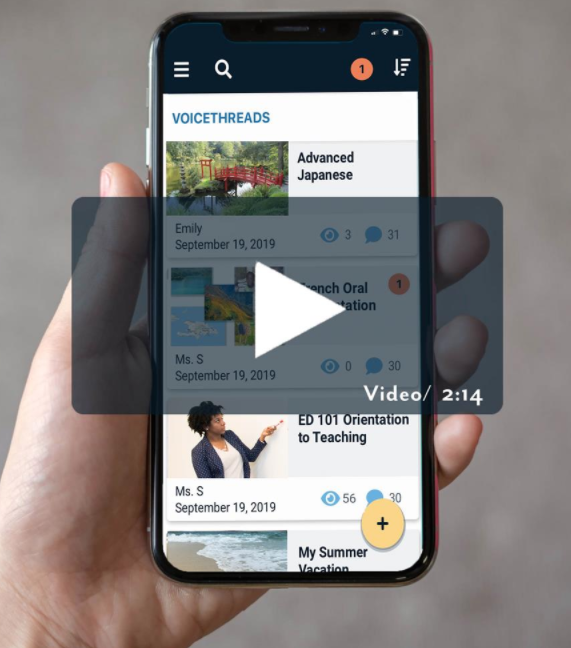
The new mobile app is here! This major update to the mobile VoiceThread experience was first released in March of 2020 and has since been updated to continue introducing new features and enhancements many times.
Updated look and feel
A clean new interface makes navigating through your VoiceThreads more intuitive. We’ve streamlined workflows and added more features to help the app work just like the desktop version.
Better organization
Sort your VoiceThreads in any way you’d like, including a new “most active” category that makes your current VoiceThreads available at a glance. We’ve improved searching, browsing your courses and groups, and account management.
Accessibility
Version 4 adds improved closed caption displays, better compatibility with mobile screen readers, and the option to translate the interface into multiple languages.


Zoom Integration

VoiceThread affords easy unscheduled human interaction, but sometimes you need the rapid back and forth that’s only available in a live meeting. Our integration with the Zoom web conferencing platform allows you to pull in any live meeting that you’ve recorded so that you can not only share the conversation with people who missed it, but more importantly, continue to extend the conversation over time.
The Zoom integration is included in our Platinum Service package, along with automated closed captioning, double the customized training, and more! Please contact us if you would like to add this service to your license.
VT Universal + Accessibility
The new and improved VT Universal is here! In partnership with many of you and outside accessibility experts, we have redesigned the experience from top to bottom to meet emerging standards, improved workflows, and a strong foundation for future development.
What is VT Universal?
It’s an application that is fully accessible to screen readers and an interim way of interacting with the same VoiceThreads you use in the default experience. It is the first thing a screen reader will detect on VoiceThread’s website, and it can be set as your default if you rely on a screen reader.
What’s new?
In addition to an overall update in design, page flow, and contrast, we have added:
- Sorting options
- Import from media sources
- Full access to all playback settings
- Slide replacing and editing tools
- Delete a VoiceThread
- Basic stats for VoiceThreads
- Full-screen mode
- Delete comments
- Create and view/hear threaded comments in context
- Closed caption and transcript support
- Copy VoiceThreads
LTI Advantage
LTI Advantage (also called LTI 1.3) is the next generation of integration in learning management systems. It will replace the current LTI 1.1 eventually, and it is a great foundation on which the standard can continue to evolve. VoiceThread has full support for LTI 1.3, and a number of institutions are using this already. Our implementation includes:
- Full integration with every compliant LMS
- Complete roster sync, which supports adds and drops seamlessly
- Automatic copying of template course content
The transition from LTI 1.1 to 1.3 isn’t fully supported in every LMS yet, but it is supported in Moodle as of today and will continue to evolve as other LMSes add support. Please contact us if you are a Moodle administrator and would like to update now.
VoiceThread Certified Educators
Since our very first cohort in the summer of 2015, hundreds of educators have participated in our two-week course and completed a formal capstone project to be certified as VT experts. This group of passionate educators has become a community centered around strong pedagogy, student support, and online innovation. This year we hit two major benchmarks: we have run 50 cohorts and certified over 500 educators. That’s huge!
If you’d like to participate in a cohort in 2021, add your name to our waitlist to be notified when new spots open up.
Security
Security is an ongoing project that never ends, especially as the world rushes online even more quickly than anyone expected, but there are also some major benchmarks every year. Here are some of those from 2020:
- Retired TLS 1.0 and 1.1
- Retired old LTI endpoints
- CDN update to fully retire all Flash video
Coming in 2021
2020 was a year of huge new features and foundational work. 2021 will be the year of enhancement, fine-tuning, and expansion. We are so excited to have these powerful new frameworks to build on, and we can’t wait for you to see the things we have in the pipeline.
Mobile Updates
Now that the framework for our new mobile app is up and running, we have many new features and optimizations in the pipeline.
- ThreadBoxes: In a world where we can’t run in-person conferences, summits, and research days, asynchronous presentation and conversation tools are essential. We’ve seen some incredible uses of ThreadBoxes, or public display spaces for collections of VoiceThreads, to run virtual conferences already, and the next step is to make those experiences mobile.
- Grading: Students can already submit their formal assignments from the app, and our next step is to enable grading. We know instructors are always on the move, and being able to assign grades from anywhere is important.
- Mobile Browser access: Now that the entire VoiceThread experience is in HTML5, we can start to support playing and commenting on VoiceThreads in your mobile browser instead of requiring the app. While an app can provide an optimized experience, not everyone wants to install an app, and it’s important for quick access not to require it.
Universal Features
The new version of VT Universal is an exciting starting point for our entire accessibility trajectory. Up next is:
- Sharing options
- Tighter LMS and assignments integration
- Managing groups and contacts
Visit the full support page for full details.
Longer term, over the course of several years, we will be merging the Universal and “Standard” versions of VoiceThread into one single application that is accessible to everyone. This is just the beginning, and we’re excited and passionate about building a cohesive and universally accessible platform.
Assignments: Generation 2
Formal graded assignments are quickly becoming the crux of how instructors use VoiceThread, and we’re developing lots of new features and workflows to help make assessments engaging, robust, and more human.
- Point-value grading
- More flexibility with copying VoiceThreads
- Late submissions
- Option to require students to add slides to a VoiceThread
- Customizable defaults
- Display assignments on the VT Home Page
- Much more!
We’ll keep you updated as each new option becomes available so you can take advantage of them when you are ready.
LTI Advantage Transition
We mentioned above that Moodle is the only LMS that currently supports a smooth transition from LTI 1.1 to the new Advantage suite. We do know, however, that most LMSes are working on something similar, and we are partnering with them closely to test and implement those plans. As each LMS introduces a toolset plan that allows for a smooth transition without any breakage of current assignments, we’ll notify you and help you plan your move.
New Purchasing Processes
We know the purchasing process isn’t exciting, but it’s oh-so-important to how you adopt VoiceThread at the right pace for yourself or your institution. We’ve completely overhauled our system to be more intuitive, more flexible, and even more secure. The best purchasing system is one you don’t really notice, and we’re spending a lot of time making sure this works so smoothly that you don’t even know we’re there.
Security
Online security is a complex and fast-growing area, and we take it very seriously. Serving educational institutions and students of all ages means we always need to be at the forefront of security standards. In addition to making sure we are continuing with the regular maintenance, updates, and standard compliance we do every day, our security goals include:
- NIST 800-171 certification
- Begin SOC2 compliance
- Update all operating systems and PHP
- Machine learning threat detection
This is a guest post by educator and VoiceThreader, By Dr. Carolina Seiden.
During the road to reimagining learning during the times of COVID-19, VoiceThread has become a source of support for my learning community. Here are two new (to me) approaches that have come to the fore because of this reimagining of my teaching efforts.
The first idea centers around the support I can and should provide for my diversely abled and skilled groups of language learners.Take introverts for example. Numerous reports indicate that distance learning has been a welcome change for those in our communities who prefer to participate in less “public” ways. With students’ different personalities and levels of linguistic development, I have been using the “My identities” feature. Different identities create opportunities for meaningful contribution from those who prefer time to weigh their words, or go through painful anxiety when having to use their developing new language in a live setting.
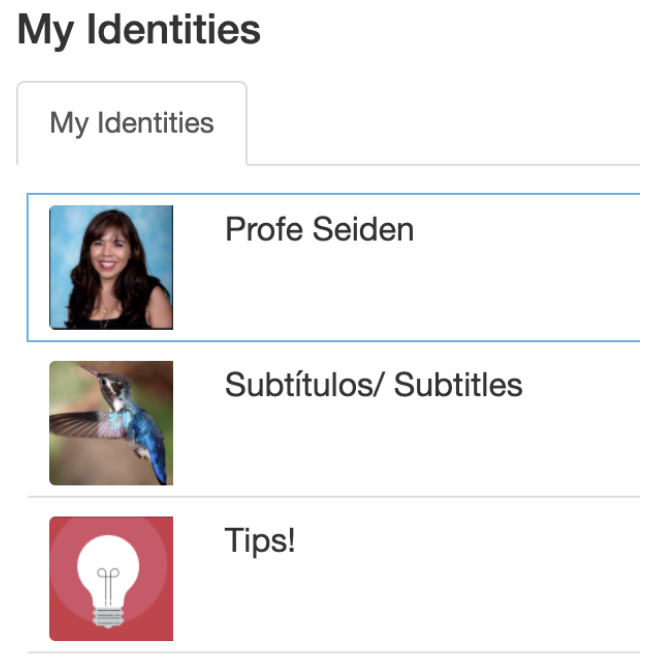
Imagine the sense of achievement felt by the students who are in charge of creating and maintaining subtitles for the work that is created in your VoiceThread’s class? Their work benefits everyone. It is meaningful, and it requires them to hone their listening skills as well as syntax and spelling. Talk about real-life applications! As a bonus, by adding CC (Subtitles) now all your work is more inclusive and accessible. Assigning this task becomes a powerful affirmation of your commitment equity in learning, while acknowledging the abilities of your students as well as the needs of the community who may view the material you are creating in VoiceThread. Similarly, creating an identity for “Tips” can enable another student(s) to share their expertise with tech and media, in order to support students in their use and exploration of VoiceThread, while using Spanish/Chinese, etc.. Now, you have more than a community of compliant students, you have a community of supportive language learners who are using their emerging skills for real life applications.
The second solution that has supported my entire class has been reimagining VoiceThread as a gallery walk. Each language learner takes on aspects of what we are covering in class and they create their project/research/proposal around it, knowing that the audience is our classmates and teacher. The final product is shared with the entire group and during class, we dedicate the entire session or at least 50 minutes, to have students “walk around the gallery” and comment on each other’s work, praise, inquire, seek clarification, build on what they see, or present an opposing view. The conversations can happen within VoiceThread, in breakout rooms, among those in the classroom and those at home, in a combination of media. Some write their comments and others verbally respond to the text shared. At the core, these are students examining the ideas that moved their peers to action, and connecting by learning about the subject, their classmates’ passion, and practicing forms of collaborative discourse in the target language.
These two ideas are a reflection of a renewed commitment to virtual learning conditions that foster a true and meaningful connection among a community of caring and curious humans. People who are discovering the world through the lens of a new language.
About the Author:
Dr. Seiden is a linguist who fell in love with technology as a catalyst of meaningful learning. She teaches Spanish and linguistics at an independent school that fostered her passion to become an Ed Tech Coach. Profe Seiden spends her time teaching, co-learning with her peers, and supporting her school’s Ed Tech world. Her beagles keep her smiling. You can find her on Twitter:_ @ProfeSeiden_

This is a guest post by Agi Bodis, Melissa Reed and Yulia Kharchenko, Department of Linguistics, Macquarie University, Sydney.
Three weeks into our TESOL (teaching English to speakers of other languages) postgraduate teacher training program the nationwide COVID-19 lockdown was announced in Australia. As university courses swiftly moved online, we were left with the task to continue the practical microteaching elements of a teaching methodology unit. These typically involved students doing short peer-teaching to develop practical teaching skills. A lot of our students were teachers already, and with their family and professional lives in turmoil, a synchronous class or a group microteaching practice were not an option. We needed an asynchronous platform where videos of teaching could be put up for viewing and commenting. The solution was VoiceThread.
For the rest of the semester, we designed and implemented a series of VoiceThread tasks supported by enabling tasks that not only helped our students achieve the unit’s learning outcomes, but also equipped them with other skills important for teachers, such as giving feedback and exercising autonomy.
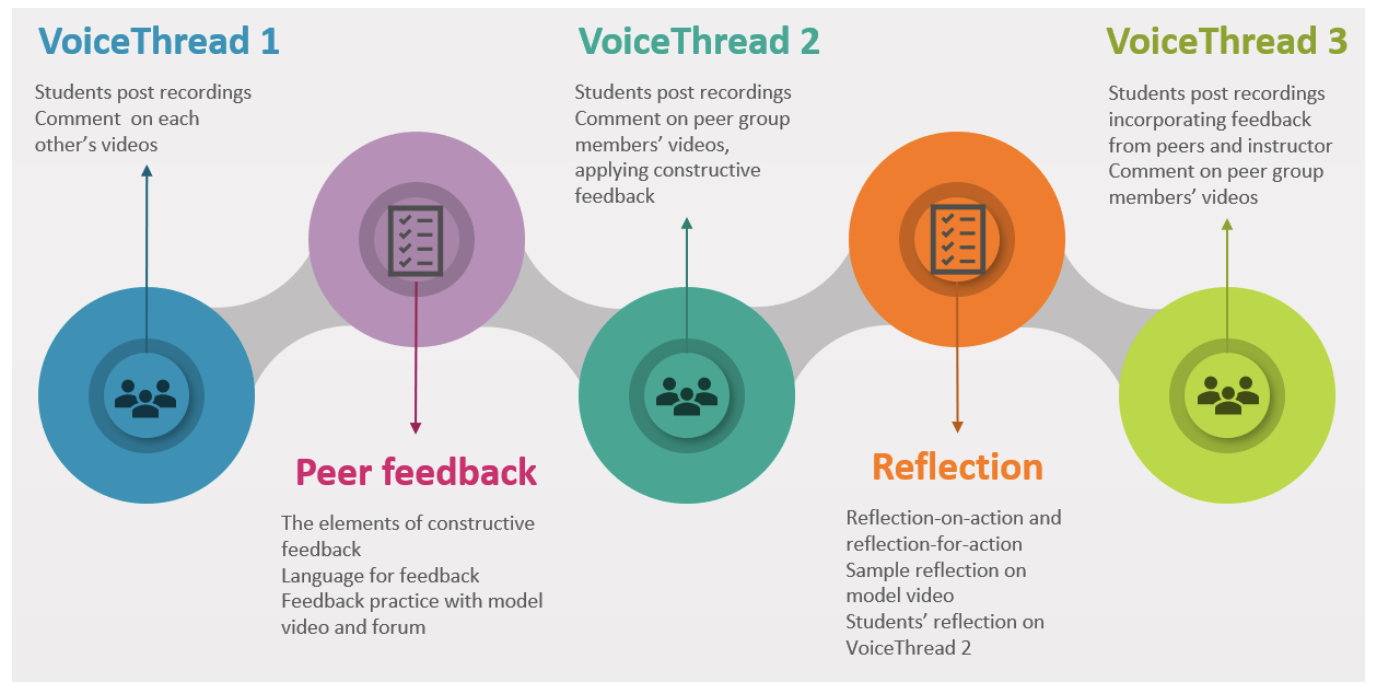
Outline of VoiceThread and Moodle task sequence
Centred on peer feedback, the VoiceThread tasks were supported by Moodle H5P activities where we scaffolded the principles and language of effective peer feedback and reflection. We then used the Course View setting on VoiceThread plugin as a common space for short videos of our students teaching various aspects of the English language. Following the instructors’ examples, their entries varied from narrated PPTs in the first task, to video recordings in subsequent exercises. In each case, students were asked to comment on at least three videos, and they did so using both text and audio options.
We were able to seamlessly integrate VoiceThread into our Moodle platform. As we moved through the unit, our students were able to showcase their new teaching skills such as class management and pronunciation instruction. At the same time, we observed improvements in their feedback literacy. Instead of ‘Great job!’ or ‘I agree with you’ we saw constructive peer feedback that noted both the strengths and weaknesses of others’ teaching. Although the VoiceThread tasks weren’t compulsory, our students were very engaged, choosing their own topics that, in the absence of students, they taught to family members, pets, stuffed toys, and even cushions.
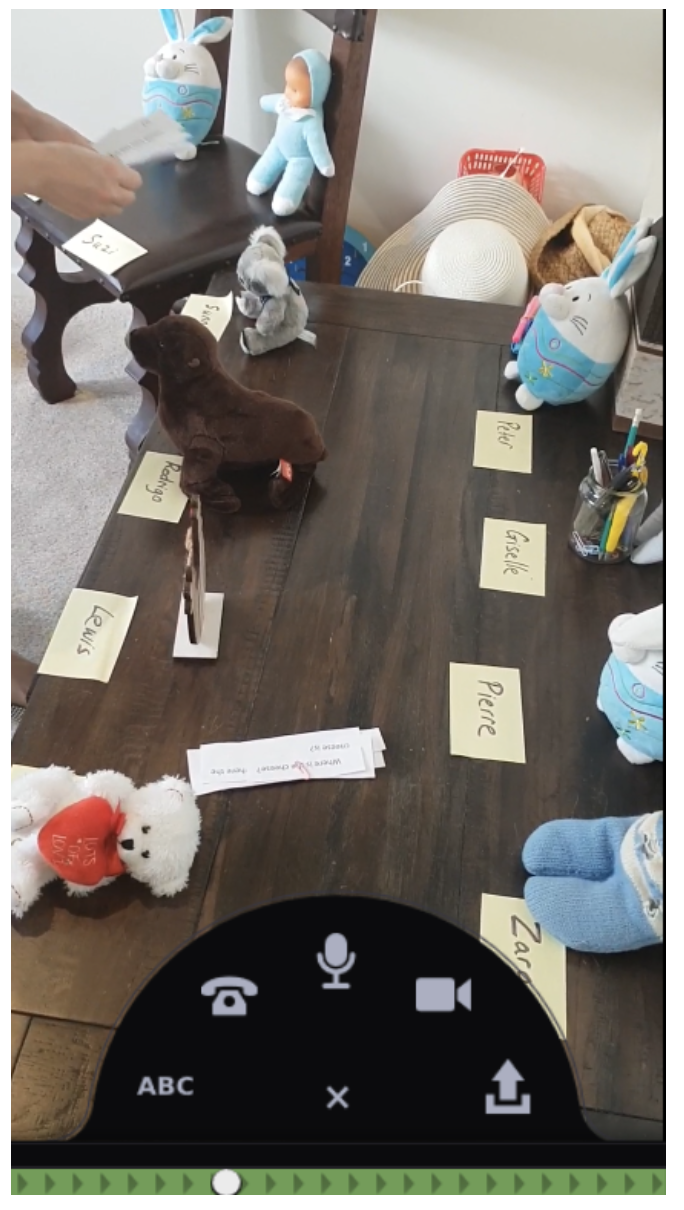
COVID-19 English language ‘students’
Although originally we had chosen VoiceThread as a platform for microteaching practice observation and formative assessment throughout the module, we soon realised that it is well suited for our final summative assessment, too. Using the Assignment setting on the Moodle plugin, we collected our students’ final microteaching videos for assessment and commentary.
In our experience, VoiceThread was a highly practical solution to the challenges of running a teacher training course in COVID-19 lockdown. In fact, the combination of VoiceThread and Moodle tasks worked so well that it is here to stay for the future semesters.
A more detailed description of the tasks can be found in our article Microteaching in Isolation: Fostering Autonomy and Learner Engagement through VoiceThread [https://www.tesolunion.org/journal/details/info/0NDkucNzIw/Microteaching-in-Isolation:-Fostering-Autonomy-and-Learner-Engagement-through-VoiceThread]
About the Authors:
Agi Bodis, Melissa Reed and Yulia Kharchenko teach on a Postgraduate TESOL course at the Department of Linguistics, Macquarie University, Sydney. Their research interests include curriculum and assessment design, professional development, sociocultural learning, and language policies in education. You can follow them on Twitter at:
@AgsBod
@MelissaReedELT
@YuliaKh_ELT
This is a guest post by online Math Teacher and VoiceThreader, Audrey McLaren.
I can’t say that this year has been a normal one for me, but it’s been closer to normal than 2020 was for most teachers. I’ve been teaching online for 12 years. I work for LEARN, a non-profit organization in Quebec, Canada, that has been providing synchronous online math and science instruction for Quebec’s English high school students for almost 20 years. So apart from, you know, all the 2020 surprises, it’s been business as usual at LEARN, which meant enthusiastic usage of one of our favourite tools, VoiceThread.
A little more background: Soon after I started teaching online, I also started using a strategy some call “flipping” my class. It’s a practice in which direct delivery of content happens outside the classroom via recorded lessons, and everything else – practice, group work, consolidation activities, presentations, you name it - happens during class. There’s a lot more to it than that, of course, but for the purposes of this article that’s all you need to know about it. VoiceThread fits in because it’s what I use to create my recorded lessons.
I chose this platform for three reasons. First, it’s easy to use. I simply upload my own PowerPoint slides, then narrate the lesson using the comment tool. Second, the platform makes it really easy and intuitive for students to interact directly with the content by commenting on individual slides – and by the way there are many ways they can comment – by text, voice, pen, microphone, or webcam. Third, it blurs the lines between asynchronous and synchronous learning. What happens in the VoiceThread most definitely does not stay in the VoiceThread!
Here’s an example: This slide was about what happens when you add the same two vectors in the opposite order. The example had just suggested that vector addition is commutative. In my comment on this slide, I gave this question prompt: “Are these two resultants different since they’re not in the same place?”
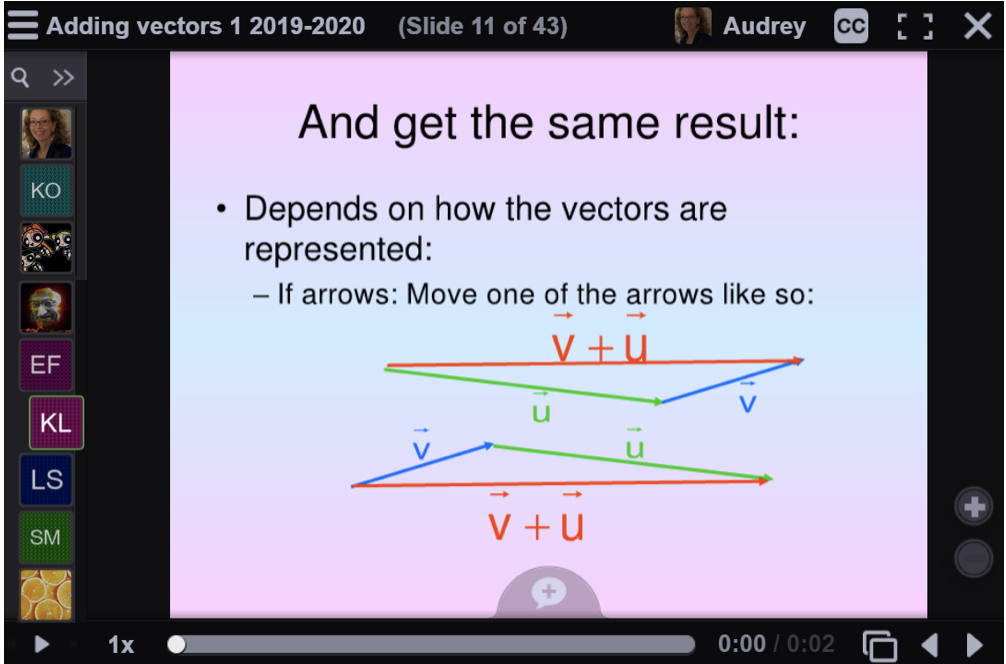
Before class the next day, I collected their replies, because they all contained gold for us to mine together in the live class. This is what I displayed during next day’s class (names have been changed to protect student privacy):
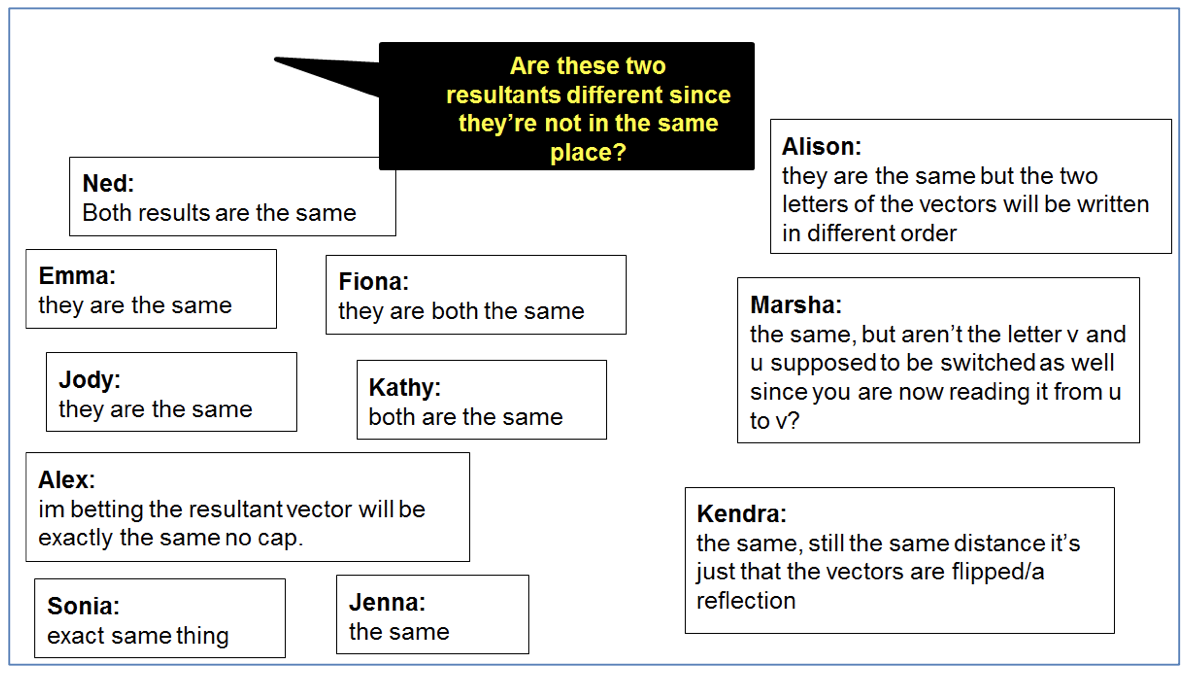
I’d grouped on the left the replies that were correct, but didn’t go into any depth, so I spent the first few minutes in class asking some of those students to defend their assertion. Next I focused on those on the right. These went a bit deeper, and as such became the jumping off point for our investigations. They raised interesting questions, none of which I intended to answer, but all of which the group’s investigations would collectively answer. This is where the blending of asynchronous and synchronous happens. Each informs the other, and even improves engagement, because the discussion has begun before students even come to class, so the ice has been broken, at least a little bit. In this way, what happens in class is student-driven.
Using VoiceThread to flip my class addressed many issues that I remember facing 12 years ago, and that I’m sure many will this coming year. For example, when you’re teaching online, and you can’t see your students, the absence of body language, facial expressions, and tone of voice can make the whole experience very lonely. If you thought it was hard to get kids to participate face-to-face, well, buckle up, because it can be even harder online. Teenagers are loathe to draw attention to themselves, and it’s really easy for them to become online-invisible. And on the student end. when you’re learning in an online class, the potential for it to feel cold and disconnected from the real world is huge. Teenagers are still kids, and they still need to know their teacher knows them and cares about them. For these reasons, communication amongst all participants in the online classroom has to be frequent, easy, and safe. A tool like VoiceThread, which is built for communication, can really help – in and out of class. I think of my VoiceThreads as a garden, in which I plant seeds, and which I harvest for my live class.
About the author:
Audrey has been teaching math for 33 years, the last 12 of which she has taught online for LEARN. She loves her job, edtech, connecting with people, and writing. She blogs at_ audrey-mcsquared.blogspot.com, and her twitter handle is_ @a_mcsquared. She is also a gardener.
This is a guest post by Nursing Educator and VoiceThread, Dr. Carol Persoon Reid.
Poster Sessions are a staple at most professional conferences, and nursing is no different. Students in the capstone course of the Bachelor of Science in Nursing (BSN) program were assigned to create a poster to highlight the scholarly project each completed in the clinical practicum portion of the course. The Poster Session was to be an opportunity to showcase the culmination of a semester-long 180-hour clinical practicum and provide an opportunity to practice presenting and attending a conference poster session.
Then the COVID-19 pandemic hit and the clinical sites went into disaster planning mode and all student clinical experiences were suspended and on campus classes were moved to online. Students were experiencing significant challenges: many were working in healthcare and were on the front lines, preparing for or caring for individuals with the COVID disease. Presenting on Zoom wouldn’t provide the same experience, and most students’ lives were so disrupted that the typical 4-hour class session was nearly impossible to schedule now that they had families who needed attention, limited childcare options, children requiring homeschooling, and demands on the limited resources they did have available (computer, space, internet, etc.).
I needed to find a way to provide students with the opportunity to complete the assignment and meet the course and program outcomes. Students had worked hard to get to this point in their education. Each capstone project was a solution to a problem facing nurses, and students were proud of their work. I wanted to showcase their clinical scholarly project, give them the opportunity to share their work, and to see the work of others as they move on to the next phase of their nursing careers. At the same time, provide an opportunity to practice this important scholarly activity of presenting a poster.
VoiceThread to the rescue! VoiceThread offered a way for students to present their work, interact with others, and discuss the projects about the implications for patient safety and nursing practice. The on-campus poster sessions was converted to a electronic poster session module using VoiceThread.
The poster assignment guidelines and tips for creating a poster were provided to students, along with a poster template in PowerPoint with headings that aligned with the assignment guidelines, color schemes and university affiliations. Students were instructed to provide the information from their clinical experience to complete each section of the poster.

I provided the following instructional material:
The students were given the following instructions:
-
Create a single slide PowerPoint using the template provided following the assignment guidelines.
-
Prepare a five minute “elevator speech” on your poster. Include a quick overview of the clinical site to provide situational context, then identify the problem you were addressing, an overview of your literature review, describe your scholarly product, and finally, discuss the evaluation results.
-
Upload your poster to the VoiceThread Assignment folder in Content for week 14.
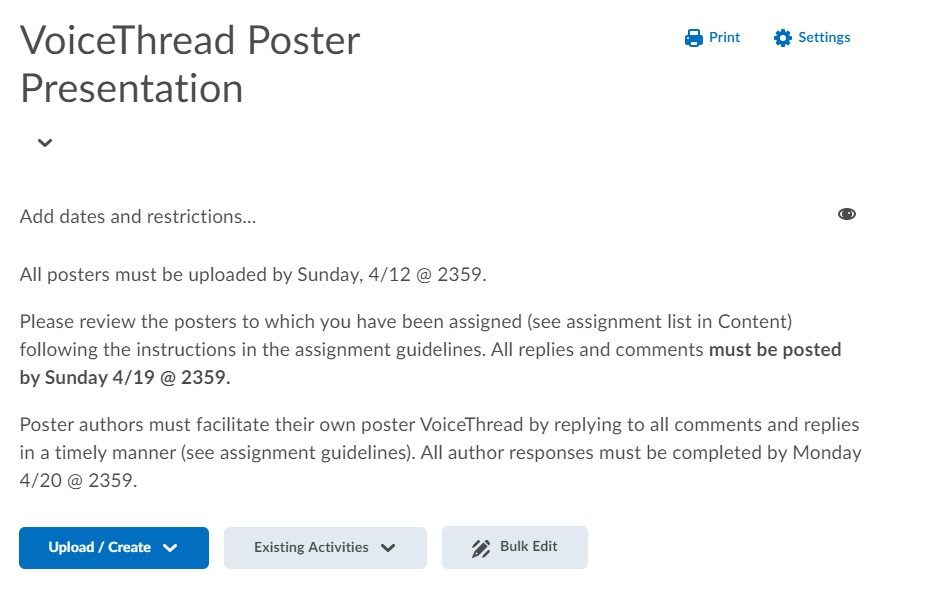
-
Record your “elevator speech” with your poster using VoiceThread.
-
Facilitate your poster presentation by responding to the comments and questions of your peers in a timely manner.
-
Each student must review a minimum of three posters. You must respond via VoiceThread to each poster presenter assigned with a thoughtful, professional comment / question that demonstrates you have read the poster and listened to the “elevator speech”. Ask a question or comment that spurs discussion with your peer about the project and outcome.
Evaluation was easy – I could listen to each presentation along with the peer comment/question or I could search for a particular student and review that student’s poster and comments/questions to peers at one time.
The student feedback was very positive. They were pleased to be able to showcase their capstone scholarly products. They engaged in thoughtful discussion about real-life clinical problems and evidence-based solutions. The asynchronous format allowed them to be successful in this assignment at a time when most other aspects of their lives were in chaos.
Here are two examples of student submissions and how they facilitated discussion with peers.
About the Author:
Dr. Carol Persoon Reid is a Professor in the College of Nursing and Health Sciences at Metropolitan State University. She is an experienced pediatric nurse and nurse educator with a PhD in Nursing and certifications in nursing education (CNE) and healthcare simulation education (CHSE). She is skilled in online teaching and learning and curriculum development and evaluation. She can be contacted at carol.reid@metrostate.edu.
This is a guest post by Educator and VoiceThreader, Astrid Wilches.
Some years ago, while working on a virtual environment with limited opportunities to interact, VoiceThread gave me the chance to connect more personally with my students. Being able to talk to their peers and teacher created a bond that simply couldn’t be done in the written fashion that the class platform provided. The fact of having an application that could bring students together to discuss a given topic was priceless, so VoiceThread became the tool of choice for all my virtual and distance classes at that time.
As years went by, technology advanced and brought new tools that helped me with different purposes for my classes: some of them enabled cooperation in written texts, others permitted online voice text recording, some others focused on making slide presentations, and a few of them allowed students to exchange opinions. However, it was always clear that the one tool that integrated all the previous features and facilitated interaction, collaboration, and sharing voice messages, video, text, and images was VoiceThread.
When this recent sanitary emergency sent us to full online education mode, VoiceThread regained importance in my teaching endeavor since I needed to adapt the evaluation process of my class moving from quantitative quizzes to a more qualitative method that took advantage of technology and promoted meaningful learning. Since synchronous online exams could aren’t always reliable, I required a process-oriented approach that helps me assess students’ understanding and progression, reinforces autonomy and active learning, integrates content and skills, and encourages significant interaction, something that was achieved through VoiceThread learning portfolios.
An online learning portfolio is a great way to showcase and foster students’ learning because it gives them the chance to redeem themselves by self-correcting their work, and making the effort to improve based on feedback. Unlike exams, where students feel nervous, fail and worry about the grade, an online learning portfolio lets them concentrate their efforts on the process rather than on the final result, gives them the possibility to use their creativity to personalize the content and visual components, puts their computer and language skills to the test and helps them get a sense of accomplishment and ownership.
Using VoiceThread for online portfolios was a great experience because I could connect and interact with students through written and voice messages, and students demonstrated their understanding of the topics from class using varied media such as videos, sketches, texts, pictures and presentations. Unlike grading exams, checking the portfolios was an enjoyable process as I could see the variety of designs, the interesting entries that followed the same instructions but had unique styles and a individual touch that made the portfolio project much more personal. Perhaps, the most significant part was the interaction of learners posting voice and text messages in VoiceThread: it was rewarding to see how well they were using the language, how much emotion they put in their voices to communicate their interest, and how engaged they were posting and replying to peers and the teacher. VoiceThread portfolios was a game-changing experience that promoted gradual improvement and master-based learning.
Portfolio Sample:
About the author: Astrid Wilches is an EFL teacher in Bogotá, Colombia. Her passion for educational technology has led her to explore and implement several tools trying to make her classes more engaging and interactive. She has used VoiceThread for presentations, discussions, and online portfolios and is eager to try it out to promote critical thinking, metacognition and other high-order thinking skills. Her main professional interests are m-learning, in-class flipping and gamification. You can find her on twitter at:_ @AstridWilches__
This is a guest post by Special Education teacher and VoiceThreader, Lauren Andersen.
As a special education teacher of students with severe and multiple disabilities, it has been a challenge to find appropriate technological resources that meet my each and every one of students where they are at and help take them to the next level.
Since learning about VoiceThread in a technology course at Columbia University many years ago, VoiceThread has become my top resource when creating lessons for my students, developing training modules for my teacher assistants, teaching online graduate courses, and encouraging collaboration among a group of individuals.
When thrust into the previously uncharted “online learning” mandate that our country has come to know, VoiceThread has enabled me to become even more versatile and reach ALL of my learners—wherever they are. My students can see me and hear me. At the same time, they can also see visuals that I embedded and the presentation that I have created. In turn, they have the ability to respond by recording videos, recording a voice message, or even typing out words and/or adding links—whatever works best for them, individually.
Using VoiceThread, I have been able to record read alouds by showing pages of books and recording me reading them. I have been able to make stories, too. Over the weekend, I made pizza for dinner and I documented every step of the process by taking pictures. I made a simple Google Slides presentation, downloaded it as a PDF, and uploaded it to VoiceThread. From there, I was able to record myself, pose questions on each slide, and write text comments including to links to their favorite pizza making game on ABCya. This trifecta multi-sensory experience is simply not an option on most technology resources today. Though it is something that is essential to the learning process for my special learners. You can check out my pizza-making lesson here:
When I’m not working with students with severe disabilities, I’m thinking of ways to train and teach the people with whom I have the great pleasure of working with: paraprofessionals and preservice teachers.
In New York State, paraprofessionals are required to engage in professional development for a certain amount of hours. Using VoiceThread, I have created many training modules that can be used to train teacher assistants and also may serve as an integral professional development tool.
Though I am just a teacher, I have often thought about how VoiceThread can streamline the process of a new hire—particularly if that new-hire starts in my classroom as a teacher aide or assistant. Using VoiceThread, essential documents can be uploaded, discussed, and questions can be posed—entirely remotely and before they even set foot in my room. After all, my students need consistency and predictability, so providing this type of information to paraprofessionals in my classroom is critical. In regard to new hires, basic workplace training certainly seems easy if all you have to do is share a link. That’s VoiceThread!
Finally, the most incredible part of VoiceThread is its ease of use. Time is precious and valuable. So is our students’ learning. Use VoiceThread to create multi-sensory material that will be yours—forever.
**_About the Author:**
Lauren Andersen is a certified doctoral candidate at Teachers College, Columbia University. She is a full time elementary special education teacher on Long Island and teaches classes as an adjunct instructor at Columbia University and Hunter College in the department of special education. Follow Lauren on Twitter at_ @AndersenLauren1
Research tells us that combining orthographic and phonological forms of language has many benefits for language learning. Nakashima, Stephens and Kamata (2018) found that reading-while-listening increases comprehension. Mestres, Baro and Garriaga (2019) found that combining text with audio helps children (10 to11 years of age) obtain higher vocabulary when learning a second language. Valentini, Ricketts and Pye (2018) had similar findings with children between 8 and 9 years of age when reading short stories. The results were not much different when the learners were adults or when the tasks were longer. Milliner (2019) tells us that university students learned more vocabulary overtime when they when their instructors combined orthographic and phonological forms of the texts. The study that Feng and Webb completed (2019) has similar findings for university students especially when image (s) was added.
The five studies mentioned above are only a few of the recent ones that have investigate this technique. There are many more that investigate the same technique with different subjects and in different combinations. The majority of these studies indicate gains in terms of language learning. But what does that mean for us language educators? How do we make use of these research findings while working according to the standards of the American Council on The Teaching of Foreign Languages (ACTFL)? Where is technology in all of this?
Combining text with audio may have been challenging on the technical and practical level decades ago. But now with advent of technology and technological tools it is no longer such a challenge. And with VoiceThread specifically, creating this combination takes literally few pushes on the same button (go to tutorial here) . Moreover, with VoiceThread, language educators are not the only ones who can create this combination. Language learners can create it too with the same level of ease and possibly more benefits.
So, let us go through several combinations that I myself have used and am using, in which text, audio, and image are be combined effectively for the purpose of language teaching and learning all of which created by the student rather than the instructor.
- Students created vocab list.
Students centered learning and student collaboration are major pedagogical practices that language educators adopt in their teaching as they try to implement the 21st Century Skills Map.
I designed the VoiceThread-based activity below in a way that follows these tow practices, where students in Advanced Arabic II take turns each week to create the vocab list for that week.
And to get the benefits of combining text with audio, the student whose turn it is must upload the written list and a recording of the same list. Other students use this vocab list to help them as they prepare for the week’s reading.
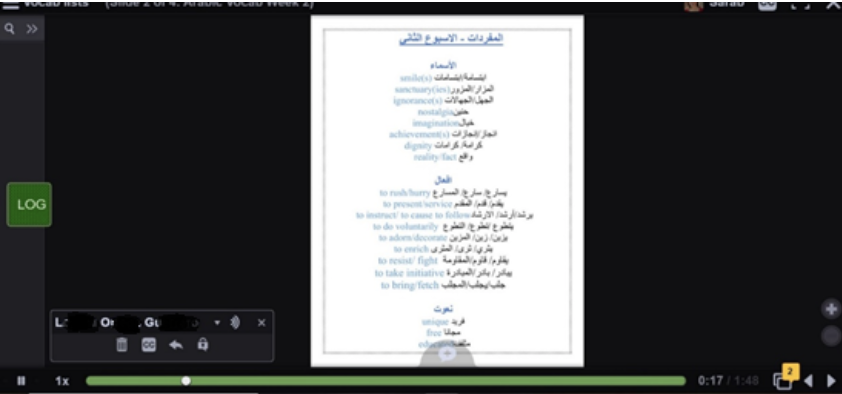
Picture 1 Students on Advanced Arabic II create their own vocab list with text and audio
2. Students final project; a short story.
As students in Intermediate High-Level work to produce language in the paragraph level rather than the sentence (or sting of sentences) level, it becomes important for the language educator to design activities that target this type of production. This is one such task. Without going into the full details, my students of Intermediate Arabic I, must write a short story as one part of their final project. They must select a theme that is culturally appropriate, work on their draft with me, their TA, and/or their language partner to finalize it. Once they are done, they then create a VoiceThread in which they must add the text along with appropriate pictures and audio recording (create an e-book, plus audio). During the last few of days in the semester, students read and listen to the stories their colleagues created and give each other feedback.
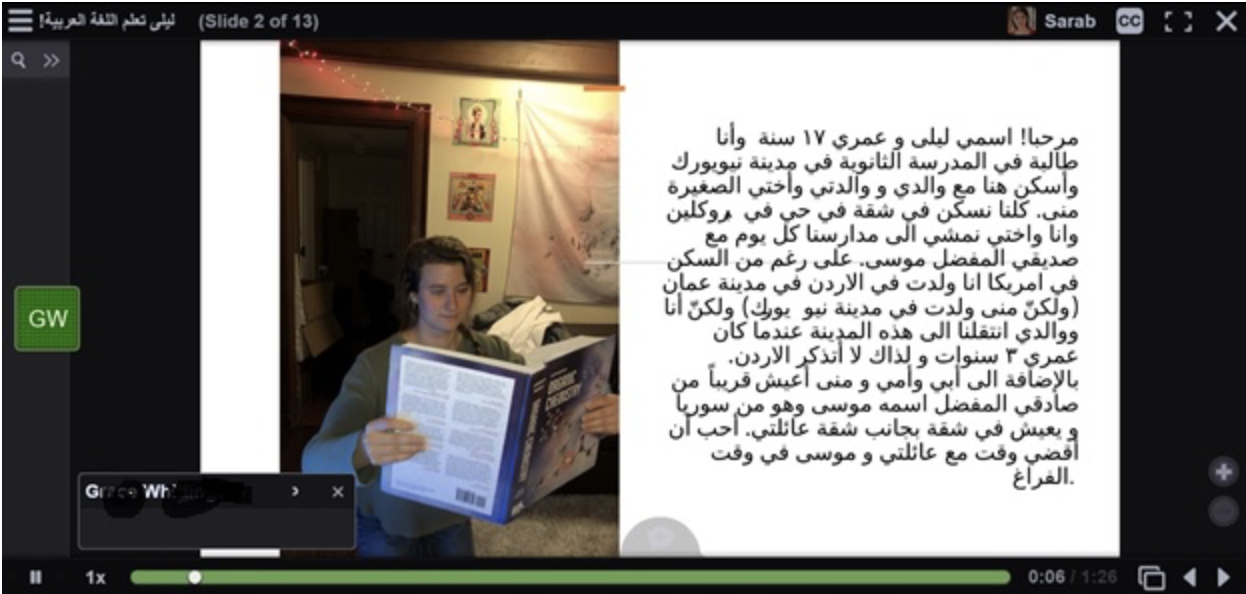
Picture 2 Students of Intermediate Arabic I create their own short story with image, text and audio
3. Students share findings.
When defining Connections as one of the 21st century skills, ACTFL says: “Students are able to access knowledge in other disciplines through the target language and to reinforce concepts already learned in these disciplines in the language classroom” (ACTFL 21st Century Skills Map, p.3, 2011). To develop this skill, my students of Advanced Arabic I must, on biweekly basis, search the internet (using the target language) to find similar topics that were dealt with in class and under the same theme but in an Arab country other than the one that was discussed in class. They must show their findings in the form on an info-graph. After having completed the info-graph, they need to add a slide to a VoiceThread that I already created and that is designated for that theme. One the same slide they must also record their findings which can be identical to what they have written in the info-graph (reading it out loud) but it does not have to be (they can free-talk if they like). Students listen to their peers’ recordings and read their info-graphs. After having done so, they need to add an audio comment with a specific piece of information that might be similar, different, at odds with …etc. in comparison to what they found when they conducted their search.
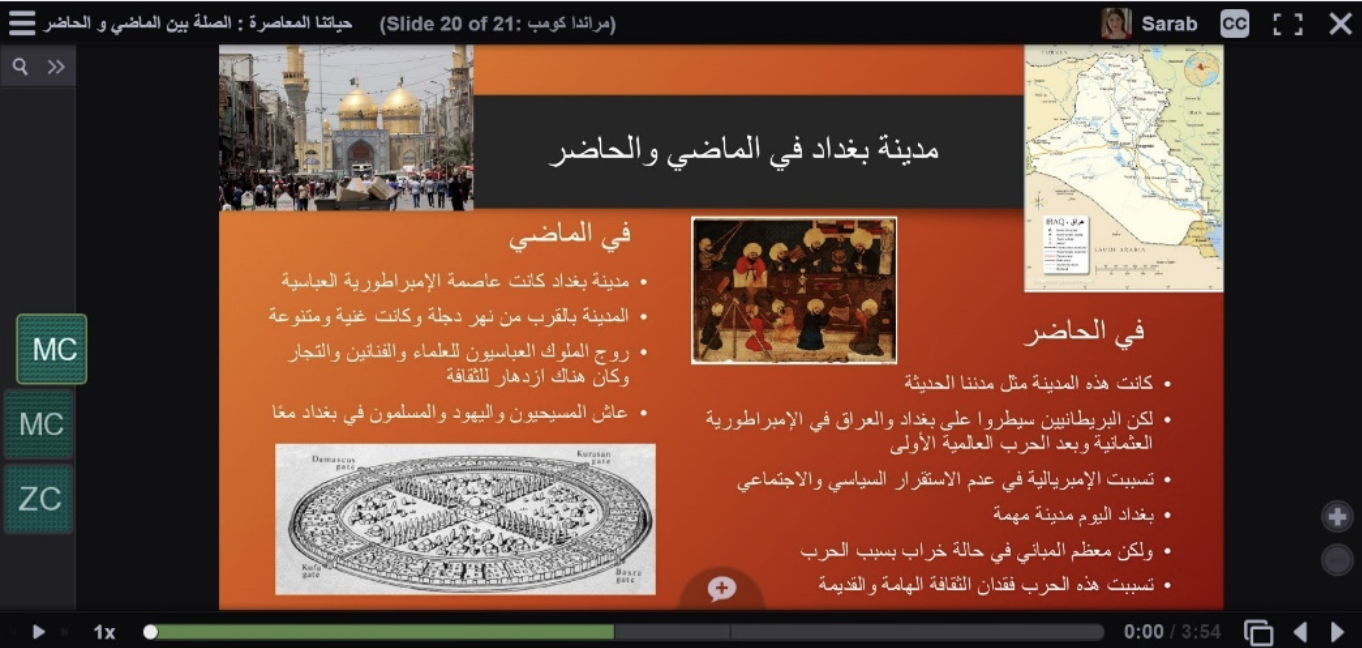
Picture 3 Student of Advanced Arabic I share their findings in a VoiceThread slide
Technology and technological education tools are not a magic solution to teaching or learning. Using research findings to guide the design learning activities is one way to ensure their effectiveness. Updating, differentiating and personalizing these tasks are other techniques to keep them effective. And always use recent, relevant and related research findings to guide the way in which to use technology.
About the Author
Sarab Al Ani is a senior lector in Arabic at Yale where she’s been teaching for ten years. Her research interests focus on using technology for language teaching, teaching Arabic in the U.S., improving second language skills with minimum of difficulty, and optimum testing methods. She also offers online courses on Second Language Teaching and Learning with ViaX. She is one of the leadership members of the New York Arabic Language Teachers Council where she offers teacher training workshops and presentations. A writer and a blogger, she wrote two Arabic Language teaching books, blog posts for the Center for Language Study at Yale, the American Association of Teachers of Arabic blog, as well as New Education Blog. Sarab is an active certified tester and rater with the American Council on the Teaching of Foreign Languages for both the Oral Proficiency Interview as well as the ACTFL Assessment of Performance Towards Proficiency in Languages test. https://campuspress.yale.edu/sarabalani/
Resources:
ACTFL. (2011). 21st century skills map.
Feng, Y., & Webb, S. (2019). LEARNING VOCABULARY THROUGH READING, LISTENING, AND VIEWING: WHICH MODE OF INPUT IS MOST EFFECTIVE?. Studies in Second Language Acquisition, 1-25.
Mestres, E. T., Baró, À. L., & Garriga, À. P. (2019). Linguistic and non-linguistic outcomes of a reading-while-listening program for young learners of English. Reading and Writing, 32(3), 819-838.
Milliner, B. (2019). Comparing Extensive Reading to Extensive Reading-While-Listening on Smartphones: Impacts on Listening and Reading Performance for Beginning Students. The Reading Matrix: An International Online Journal, 19(1).
Nakashima, K., Stephens, M., & Kamata, S. (2018). The Interplay of Silent Reading, Reading-while-listening and Listening-only. The Reading Matrix: An International Online Journal, 18(1), 104-123.
Valentini, A., Ricketts, J., Pye, R. E., & Houston-Price, C. (2018). Listening while reading promotes word learning from stories. Journal of experimental child psychology, 167, 10-31.
















